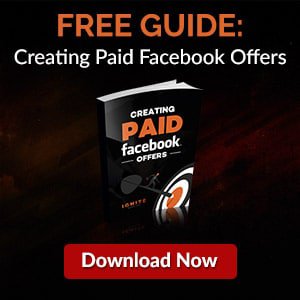


As the OG of social media platforms, Facebook outranks its peers by almost every metric—particularly in the area of advertising. In fact, HubSpot’s most recent State of Marketing Trends Report for 2022 revealed that Facebook delivers the highest direct return on investment (ROI) of all paid channels. And with the social media giant offering more unique advantages in audience targeting and scaling than its rivals, who wouldn’t want a piece of that action?
That said, running Facebook Ad campaigns can feel a lot like gambling. Make the wrong decision, and the house takes your cash. Make the right decision, and you’ll be skipping all the way to the bank.
Fortunately, you don’t have to rely on luck to win big with Facebook Ads for your chiropractic services. You simply need the right strategy.
So, if you’re a chiropractor who wants to capitalize on Facebook Ads or you’re hoping to strengthen your current strategy for campaigns, stick around as we give you a blueprint for creating killer Facebook Ads that deliver results every time.
Successful ad campaigns deeply depend on effective communication, so let me ask you this: who are you aiming to treat?
If you answered, “Everyone,” you’d be dead wrong.
Don’t worry; many business owners answer the same way when asked who they serve.
Here’s the thing: although you may treat everyone from newborns to 90-year-olds, you have a multitude of target audience segments within your patient base. Individuals within each of those different segments have very specific attributes and will follow a decision-making process influenced by numerous factors. For example, a parent seeking treatment for their colicky baby is different from a 60-year-old with osteoarthritis pain or a 40-year-old construction worker with lower back pain.
Understanding these groups of patients in terms of their problems, goals, desires, values, beliefs, capabilities, and limitations helps ensure you develop the right offer and ad copy for the right person, using the right voice, tone, language, and style that motivates them to take action.
And when your ad communicates effectively with the right target segment, the following happens:
There’s no “hit or miss” aspect to your marketing endeavors.
How do you get to know your ideal target audiences?
Simple: study them and create buyer personas (a.k.a. customer avatars).
A buyer persona is an archetypical representation of a real individual who might be interested in your chiropractic and healthcare services.
Your avatar should include relevant insights about your target:
Some of these insights will influence your copy more than they affect how you leverage Facebook’s targeting capabilities. For example, understanding your target’s pain points allows you to tailor your pitch and present your chiropractic services as the solution, while understanding their objections allows you to counter them in the copy.
How Do You Create Personas?
Developing patient avatars is best done with a combination of qualitative and quantitative research to gain an in-depth understanding of each market segment. Research methods often include interviews with patient-facing employees and patients, as well as surveys, online keyword research, analysis of your web analytics, and monitoring of social media groups.
When it comes to Facebook’s targeting features, there are three main options:
Ultimately, by creating buyer personas of your different audience segments, you’ll be able to drill deep into Facebook’s targeting options so that you’re not wasting your ad spend showing your ads to people who wouldn’t be interested in your offer.
Additional Tips:
The offer can make or break an ad campaign, which is why it’s so important to get it right from the get-go if you want to attract and convert potential patients without Facebook taking you to the cleaners.
So, what offers might work well for your chiropractic care?
Start by considering your value ladder.
The value ladder is a sales and marketing tool that outlines various levels of the products and services you offer in a sequence, from lower-priced items to higher-priced ones. It’s essentially designed to move customers up the ladder by offering them more valuable products or services as they build trust and become more familiar with your practice.
The rungs include free, low, mid, and high-ticket items, which serve as a useful framework for determining what will work for your audience during each stage of the purchase lifecycle.
That said, let’s take a brief look at the purpose of each category:
Free offers: introduce the patient to your brand and build trust.
Low-ticket offers: provide value and establish credibility.
Mid-ticket offers: allow those who have shown interest to make a deeper commitment.
High-ticket items: let you pitch premium offers to your most engaged and loyal patients who have already bought from you.
Here’s an example of the offer matrix for chiropractors:
| Business Type | Free | Low-Ticket | Mid-Ticket | High-Ticket | |
| Chiropractor | Consultation / Exam | $21 Adjustment | Nutritional Plan / Infrared Therapy / Specialized Treatment | Long-Term Care Plan | |
The ultimate goal is to provide a path for patients to gradually increase their investment in your practice and move towards higher-value offerings. This approach also helps eliminate objections as there’s little to no risk on the first rungs of the ladder.
Next, you need to consider your audience and their needs.
For example, if you charge $150 per adjustment, the free and low-ticket items in our grid above will make sense for an audience wanting to understand their pain and gain relief.
However, if you’re a chiropractor who specializes in something like scoliosis treatment (as one of our clients does), using a free educational guide about the condition and treatment options as an early entry point may be more effective in creating interest and getting the lead warmed up to have a conversation.
By using the value ladder, you can tailor your offers to meet the needs of your target audience and maximize conversions.
It may seem counterintuitive that this is the third step, but you can’t start building your campaign until you have your buyer personas and offer matrix down.
Now that you’re ready to move on, what exactly does “begin with the end in mind” mean?
Every campaign needs a goal—a single objective. Are you trying to generate fresh leads? Sell existing patients on premium care packages? Build a patient base for a particular treatment offering? Whatever it is, you need to keep your goal in focus.
You also need to think about your target patient’s goal, too.
What is your target’s goal?
The answer depends on what stage they’re at in the buyer journey.
The buyer’s journey is a research and decision-making process commonly divided into three phases:
How do you tie your goal and what your target audience is looking for together?
Ask yourself these four critical questions:
You may need to brainstorm several offer ideas for various audience segments at different awareness stages because achieving the best ad response usually depends on ad testing. You can read more about this in our post on what chiropractic Facebook Ads seem to get the best response.
Once you’ve figured out your offer, it’s time to create the key pieces of your campaign, namely your Facebook Ad, funnel, and follow-up.
When it comes to your ad, there are three elements that make an effective campaign.
The ad copy and design are commonly known as the ad creative.
What makes a high-converting Facebook ad creative?
Here are some examples of effective lead and new patient-generating offers from chiropractic clinics:
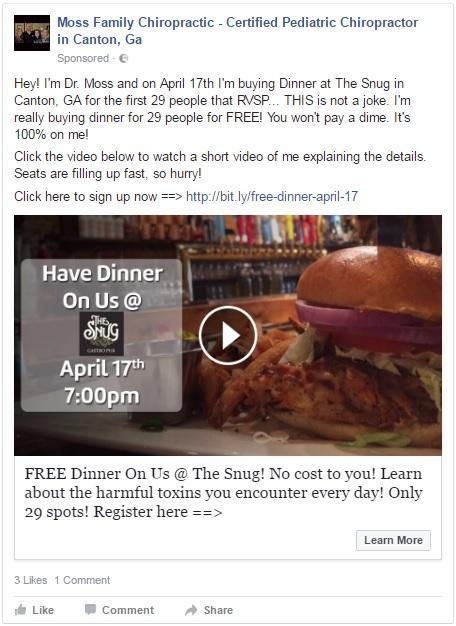
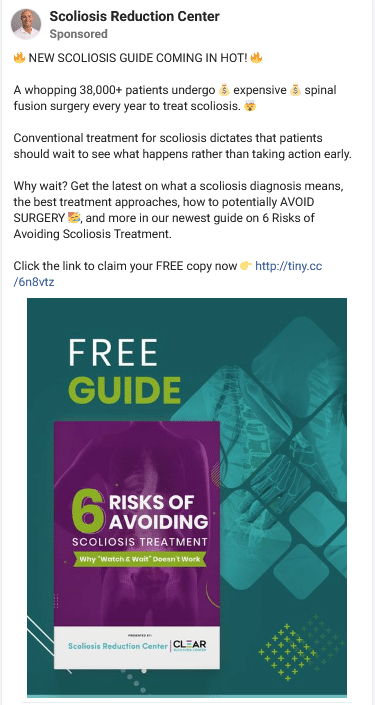

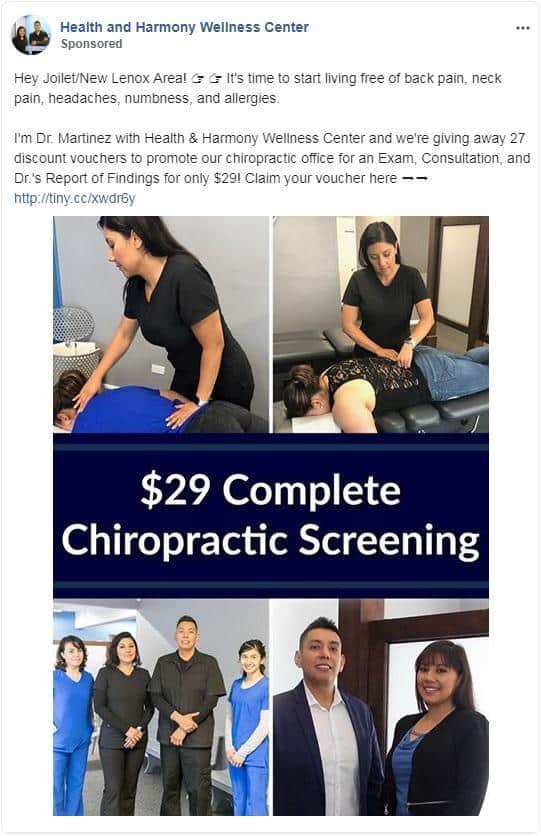
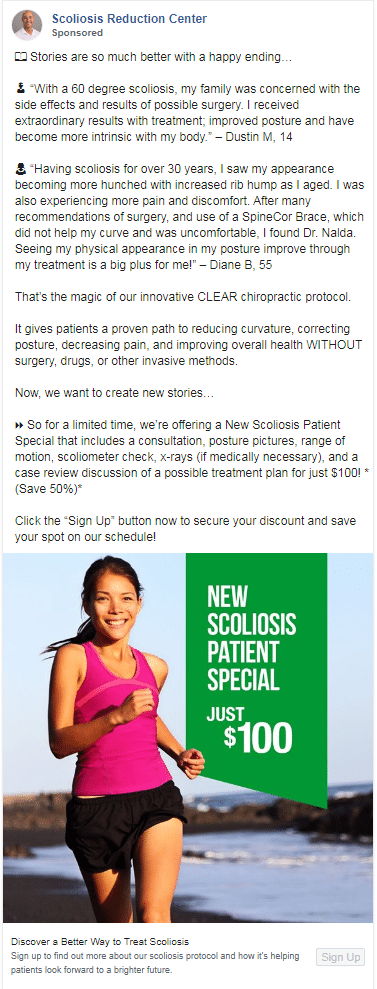
Once you have your ad creative figured out, it’s time to create the funnel assets that will move your prospect from your Facebook Ad to the next stage of the customer journey.
While you can learn more about local business funnels and how to convert visitors into leads like a boss by visiting our extensive post on landing pages, forms, and CTAs, here’s a quick breakdown of funnels.
Typically, there are two main components of a funnel:
What makes for a successful landing page?
A landing page must have several elements to convert leads effectively and drive conversions. Here’s a checklist to help you create yours:
What about thank you pages?
A good thank you page should have the following:
Fortunately, there are several super simple, all-in-one solutions to help you build out your funnels, including ClickFunnels, LeadPages, and GrooveFunnels. It’s simply a matter of choosing one that suits your budget and skill level.
A well-thought-out follow-up process can drastically improve your relationship with prospects and increase the number of people who close from leads into paying patients.
A follow-up system is simply a way to track and move leads through each phase of your sales cycle by way of various touchpoints. These touchpoints generally include autoresponder emails, phone calls and/or voice drops, and text messages. Essentially, the lead enters the top of your funnel by signing up for your offer. They then receive the first point of contact, after which they’re nurtured through the funnel to the point of paid conversion.
So, what does a lead nurturing or follow-up sequence typically look like?
Email 1: the immediate delivery of the free or low-ticket offer. This may be a coupon code to claim a voucher at your practice, a downloadable file like an eBook or guide, or additional details for an event.
Email 2: a 5-day reminder to claim the offer, as well as educational content on the pain your service solves.
Email 3: a 3-day reminder to claim the offer with a credibility-builder like a HIPAA-compliant case study showcasing a successful patient case.
Email 4: a 1-day reminder to claim the offer with patient testimonials relevant to the offer.
Email 5: A final reminder that makes it clear the offer is ending and this is their last chance to get the thing they signed up to receive.
Based on the offer, your sequence could include additional points of contact. For example, along with email #1, one of your office staff might phone the lead to schedule their free consultation or exam. Tools like ActiveCampaign and GoHighLevel can help you automate parts of this process, making sure you track leads and their response to every interaction.
While the steps outlined above will help get you on track to a killer Facebook Ad that gets results for your chiropractic services, here are additional tips and answers to questions that may come up as you’re building your campaign.
Ads charged for clicks, video views, likes, and similar actions require at least $5 per day. However, we recommend that you aim for at least $30 per day to get optimal results.
Facebook has several bidding options available: run the ad continuously, set bidding to automatic, bid your amount manually, or set a date and time limitation on your campaign.
We recommend setting your bidding to automatic or running the ad continuously.
You can learn more about Facebook’s best practices for advert bidding and budgeting here.
Although you’ll want to go through Facebook’s Ad policies thoroughly to ensure your ad account isn’t suspended or permanently terminated, you’ll want to pay strict attention to the following rules when running chiropractic ads:
Your ad’s lack of results could stem from several factors, including misalignment between your target audience and the offer being advertised, incorrect audience targeting, an audience that’s too broad or too narrow, over-reliance on interest targeting, poor ad placement, or wrong budget parameters. It could also be because you’re using inappropriate ad types for the situation, your ad creative is unengaging, and your landing page isn’t adequately optimized.
It’s also important to note that ad performance tends to wane over time as your campaign becomes more susceptible to ad fatigue.
Besides fixing the issues mentioned above, you can revive dead ad sets by:
With numerous factors to consider, creating a successful Facebook Ad campaign as a chiropractor can be challenging. However, Facebook still offers one of the most affordable and convenient ways to market your chiropractic practice online. Before you give up and ditch the platform, experiment with different offers to determine which generates the highest response rates for your practice. You might just be pleasantly surprised with the results.
Need guidance on Facebook Ads or assistance with running a campaign for your practice? Take advantage of our complimentary 15-minute consultation. Click here to schedule your appointment today!
